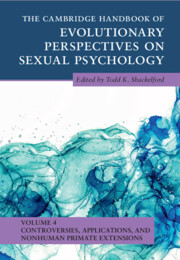Book contents
- The Cambridge Handbook of Evolutionary Perspectives on Sexual Psychology
- The Cambridge Handbook of Evolutionary Perspectives on Sexual Psychology
- Copyright page
- Contents
- Contributors
- Preface
- Part I Controversies and Unresolved Issues
- 1 The Female Sexual Orientation Spectrum in Evolutionary Perspective
- 2 The Evolution of Female Same-Sex Attraction
- 3 Male Bisexuality
- 4 Female Bisexuality
- 5 Masturbation in Primates
- Part II Applications to Health, Law, and Pornography
- Part III Nonhuman Primate Sexual Behavior
- Index
- References
3 - Male Bisexuality
from Part I - Controversies and Unresolved Issues
Published online by Cambridge University Press: 30 June 2022
- The Cambridge Handbook of Evolutionary Perspectives on Sexual Psychology
- The Cambridge Handbook of Evolutionary Perspectives on Sexual Psychology
- Copyright page
- Contents
- Contributors
- Preface
- Part I Controversies and Unresolved Issues
- 1 The Female Sexual Orientation Spectrum in Evolutionary Perspective
- 2 The Evolution of Female Same-Sex Attraction
- 3 Male Bisexuality
- 4 Female Bisexuality
- 5 Masturbation in Primates
- Part II Applications to Health, Law, and Pornography
- Part III Nonhuman Primate Sexual Behavior
- Index
- References
Summary
Compared to the body of literature on male homosexuality, the continuum of bisexual orientations between the exclusively homosexual and heterosexual poles has been largely overlooked in the scientific and evolutionary literature. Possibly, male bisexuality is not as hard a puzzle to evolutionary thinking because it does not reduce individual direct reproductive success as much as exclusive male homosexuality. Or, bisexual men are expected to fall in between the exclusive poles of sexual orientation, and they thus would not differ from them in the studied characteristics. Moreover, the existence of bisexual men has sometimes been doubted or denied in scientific and lay literature. Despite recent Western biphobia (and homophobia) aimed specifically at men, we show that different forms of male sexuality aimed at both men and women are common among different human populations and non-human species, making it a viable candidate for evolutionary analysis. We first outline the concept and measurements of male bisexuality, its prevalence, and after reviewing the proximate socio-biological factors associated with male bisexuality, we outline evolutionary hypotheses on male bisexuality. We show that several hypotheses originally designed to explain exclusive homosexuality apply also to bisexuality, although most of them deal with the more feminine form of male non-heterosexuals. Finally, we outline the importance of studies on bisexuality for evolutionary psychological science.
Keywords
- Type
- Chapter
- Information
- Publisher: Cambridge University PressPrint publication year: 2022
References
- 8
- Cited by



